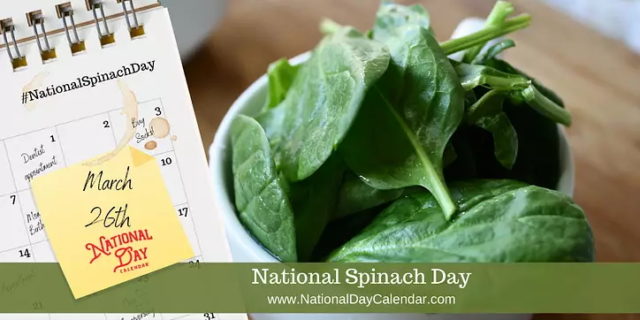
On March 26th each year, National Spinach Day reminds us of the health benefits packed into this leafy green vegetable. Not only are there so many delicious ways that you can enjoy spinach, but it is also incredibly good for you!
- An annual plant, spinach grows natively in central and southwestern Asia. Thought to have originated in ancient Persia, Arab traders carried spinach into India and then later introduced into ancient China. There it was known as “Persian vegetable.”
- The earliest available record of the spinach plant was found in Chinese, saying that the spinach plant was introduced into China via Nepal.
- Spinach is a native plant of Persia (modern day Iran). It was introduced to China in the 7th century. It was most probably brought to Europe in about the 12th century and to the US in 1806.
- Reflecting its origin, spinach is still widely known in China as “the Persian Green”.
- During her reign as queen of France, Catherine de Medici enjoyed spinach so much, it was served at every meal. To this day, dishes made with spinach are known as “Florentine” reflecting Catherine’s birth in Florence.
- Spinach is eaten raw or cooked and is available fresh, frozen or canned.
- Spinach is one of the best sources of iron. And an excellent source of calcium, folic acid, fiber, protein, calcium and vitamins A, C and K. Spinach is loaded with cancer-fighting antioxidants, believed to help improve cardiovascular and gastrointestinal health.
- Following China, the United States produces the world’s second-largest crop of spinach.
- California, Arizona, and New Jersey are the top spinach producing states in the United States.
- Types of spinach:
- Savoy: dark green color with curly leaves; usually sold in fresh bunches.
- Flat or Smooth Leaf: broad, smooth leaves; mostly grown for canned and frozen spinach as well as soups, baby food, and processed foods.
- Semi-savoy: a hybrid variety with crinkly leaves: is sold fresh and processed.
- Spinach is a cool season crop and belongs to the goose foot family along with Swiss chard and beets.
- In the 1930’s U.S. spinach growers credited Popeye with a 33% increase in domestic spinach consumption – a welcome boost to an industry during the depression era.
- The spinach growing town of Crystal City, Texas, erected a statue of Popeye in 1937.
- The creator of the comic strip character, Popeye, E.C. Segar was a vegetarian and as a way of promoting the benefits of vegetables, he boosted his character’s strength with a known iron-rich food. Popeye has been portrayed since 1931.
- ‘Birds Eye’ was the first company to advertise frozen spinach. It did so in “Life” magazine in 1949.
- Alma, Arkansas (population approx. 4,700), holds an annual spinach festival each April, organized by the Alma Chamber of Commerce. Alma proclaims itself to be the “spinach capital of the world”, a title also claimed by Crystal City, Texas. Alma is the home of “Allen Canning Company” which cans and ships spinach.
- Medieval artists extracted green pigment from spinach to use as an ink or paint
- Name “Spinach” is derived from the word ispanai meaning green hand. In Latin it became spanachia which eventually evolved into the present word.
- It can neutralize explosives. This research dates back to the late 90s and, if you were a 90s baby (or loved Looney Tunes cartoons), seems fitting in a Wile E. Coyote and Road Runner skit: Spinach enzymes neutralize explosives. The Pacific Northwest National Laboratory study found nitroreductase enzymes, naturally found in spinach, can eat, digest, and transform explosives such as TNT.
- It can make workouts easier. Preliminary research published in Cell Press found spinach might make your muscles more efficient during a workout.
- On average, each American eats 1.4 kilograms (3 pounds) of spinach a year.
Sources:












